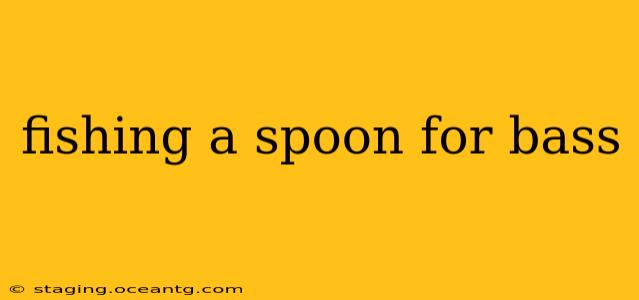Spoon lures are a classic choice for bass anglers, offering a versatile approach to targeting these prized game fish. Their shimmering, fluttering action mimics injured baitfish, triggering aggressive strikes from even the most finicky bass. However, mastering the art of spoon fishing for bass requires understanding the nuances of retrieve techniques, location selection, and choosing the right spoon for the job. This comprehensive guide will delve into the intricacies of this effective fishing method, helping you land more bass.
What are the best spoons for bass fishing?
The best spoon for bass fishing depends on several factors, including water clarity, depth, and the type of bass you're targeting. However, some consistently effective choices include:
- Colorado Spoons: These spoons feature a wider, more rounded profile, creating a significant wobble and flash that attracts bass from a distance. They excel in stained or muddy water.
- Indiana Spoons: Indiana spoons have a slightly narrower profile than Colorado spoons, resulting in a tighter wobble and a more subtle flash. They are great for clear water situations.
- Kastmaster Spoons: Known for their durability and consistent performance, Kastmaster spoons offer a reliable option for a variety of bass fishing scenarios. Their weight and shape allow for deep diving capabilities.
- Johnson Spoons: Another classic choice, Johnson spoons are available in various sizes and finishes, making them adaptable to different fishing conditions.
What retrieve is best for fishing spoons for bass?
The retrieve you use will significantly impact your success. Experimentation is key, but here are a few proven techniques:
- The Steady Retrieve: A consistent, even retrieve is a great starting point. This mimics a fleeing baitfish and can be particularly effective in open water.
- The Stop-and-Go Retrieve: This technique involves reeling in steadily for a few seconds, then pausing for a moment before resuming the retrieve. The pause allows the spoon to flutter enticingly, often triggering a reaction strike.
- The Lift-and-Drop Retrieve: This retrieve involves lifting the rod tip to raise the spoon, then letting it sink slowly. This technique is especially effective near cover or structure.
- The Jigging Retrieve: This aggressive retrieve involves rapidly raising and lowering the rod tip, creating a darting action that imitates a panicked baitfish. It works best in shallow water.
What time of year is best for spoon fishing for bass?
Spoon fishing can be productive throughout the year, but certain times offer more favorable conditions. Spring and fall are generally excellent periods, as bass are actively feeding during these transition seasons. Summer and winter can also produce results, though you might need to adjust your techniques based on water temperature and bass behavior.
What is the best depth to fish spoons for bass?
The ideal depth depends on the specific spoon you're using, as different spoons dive to different depths. Consider the size and shape of the spoon, along with the water's depth and structure. Experimentation will help you determine the most productive depth for each situation. However, it is important to remember that bass can be found at any depth, so don't be afraid to explore different water columns.
Where should you fish spoons for bass?
Bass are opportunistic feeders and can be found in a variety of locations. However, some areas are particularly productive for spoon fishing:
- Around Cover: Bass often hold near structure such as rocks, logs, weeds, and docks. Casting your spoon near these areas and working it slowly along the edge is an effective technique.
- Drop-offs: The transition zones between shallow and deep water are often prime feeding locations. Cast your spoon towards the drop-off and allow it to fall naturally.
- Points: The points where two banks meet can concentrate baitfish, attracting bass in large numbers.
- Open Water: In larger lakes and reservoirs, bass will often cruise open water, and a steady retrieve with a spoon can be highly effective.
What line and rod should I use for spoon fishing for bass?
A medium-light to medium power spinning rod paired with 8-12 pound test monofilament or fluorocarbon line is a good choice for spoon fishing. Fluorocarbon is less visible to fish, increasing your chances of hooking a wary bass.
Conclusion
Spoon fishing for bass is a highly effective technique that can be mastered with practice and experimentation. By understanding the various types of spoons, retrieves, and locations, you can significantly increase your chances of landing trophy bass. Remember to experiment with different techniques to find what works best in various conditions and for your preferred fishing style. Happy fishing!
